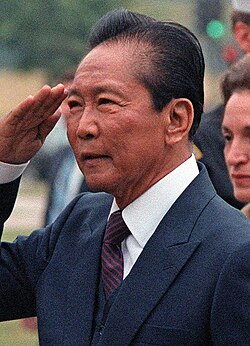Draft:Ferdinand Marcos
| Suppress the dissenters Fascism |
| Bundle of rods |
| Fascists |
| Groups |
Ferdinand Emmanuel Edralin Marcos Sr. (1917–1989) was the fascist kleptocrat dictator of the Philippines, ruling from 1965 to 1986. His initial rule was dull bureaucracy typical of right-wing leaders at the time, he eventually consolidated power in 1972 and ruled the country under martial law until 1981, granting expanded powers using the 1973 Constitution.
On a more humorous note, Marcos was born on 9/11, which makes sense as he was also a nation changing disaster who affected his country for years to come.[citation NOT needed]
Early days[edit]
Marcos was born and raised in the year 1917 in the Philippines during its era of colonial subjugation under the United States. His father, Mariano Marcos, collaborated with Japanese fascists when they invaded the Philippines, part of their larger subjugation plan to expand in Asia and the Pacific. After the war, Mariano was tried and executed by communist guerrillas for his collaboration. Despite his father’s actions, he did fight against Imperial Japan, and was captured and was among the American and Filipino soldiers captured and imprisoned by them during the war. He was also one of the surviving victims in the Bataan Death March. He was later released, possibly because of his father’s collaboration with Japanese soldiers. [1][2]
Rise to power and rule[edit]
After the Philippines gained independence in 1946, Marcos was among many lawyers who prosecuted Filipino war criminals who collaborated with the Japanese. Ironically, he claimed his father’s old post and ran as representative for his district, gaining three terms lasting from 1949 to 1959. Marcos continued consolidating power, becoming senate president from 1963 to 1965. By 1962, Marcos ran for president and won, falsely claiming that he was a decorated war hero. [3]
Overthrowal[edit]
After the Filipino people got fed from Marcos during decades of his corrupt rule, the people rebelled and began a revolution that would later become known as the People Power movement. The movement lasted for an entire day. The key successful reason for the revolution was that two of his old buddies (Juan Ponce Enrile and Fidel Ramos) turned against him and sided with the people.
Legacy[edit]
Though long gone and hated by the Filipino people, his son Marcos Jr (nicknamed Bongbong) was incredibly popular with voters, and was elected in 2022. However, the people would later regret their vote, as he proved to be just as authoritarian as his father (albeit an authoritarian right-wing centrist rather than a fascist like his old man, but the apple doesn’t fall far from the tree regardless). After being elected, Marcos quickly went to work to clear his families name and reputation, whitewashing his father’s actions.
See also[edit]
- Rodrigo Duterte - his successor, who was inspired by him to become a fascist dictator himself.
- Bongbong Marcos - his non-fascist authoritarian and buffoonish son.
- Suharto - his Indonesian counterpart.
- Mahathir Mohammad - his Malaysian counterpart.
References[edit]
- ↑ New Doubts on Marcos' War Role Washington Post
- ↑ The Marcos Mystery: Did the Philippine Leader Really Win the U.S. Medals for Valor? He Exploits Honors He May Not Have Earned Washington Post
- ↑ THE FALL OF MARCOS: TWO DECADES AS PHILIPPINE CHIEF; THE MARCOS YEARS: FROM VOW TO 'MAKE COUNTRY GREAT' TO THE PUBLIC REVOLT New York Times
